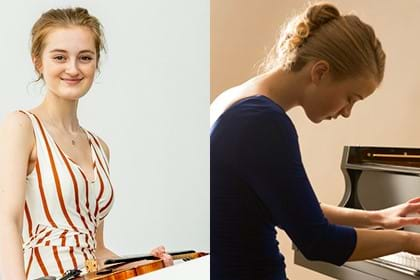…the music emerged straight from the heart
How do you prepare for your first tour to Australia?
With a piece of new Australian music, of course.
Violinist Noa Wildschut and pianist Elisabeth Brauss are about about to embark on their debut tour of this country, and they’ve been practising a new work written just for them. Melbourne composer May Lyon crafted an original piece of music called Forces of Nature, and the name of this Musica Viva Australia commission is matched to the strength of its soloists and writer alike.
May says it all began when Musica Viva Australia’s Artistic Director Paul Kildea found himself listening to some snippets of Opal – a double horn concerto May had written for the Melbourne Symphony Orchestra back in 2021. With brass instruments glistening like precious gems, Paul was so drawn into its magical atmosphere that he asked May if he could hear an extended recording of the work, in all its beauty.
From this listening experience would come an entirely new piece of music, for two entirely different instruments.
‘He really loved the work, which I was very flattered by, after which he asked to catch up,’ May said of the composer’s burgeoning musical friendship with Paul. They had a ‘great meeting’ – and it kicked off the commission for Wildschut and Brauss.
‘We had discussed that it was important that composers and performers are the right match,’ May shares. And the pressure is on when you’re tasked with contributing to a string of successful Musica Viva Australia commissions. This year alone, Australian composer Jakub Jankowski wrote for koto and cello (in the event Silk, Metal, Wood), while Carl Vine’s music for guitar and string quartet was premiered by Karin Schaupp and Flinders Quartet.
May, Noa and Elisabeth may not be a close geographical fit, but they are certainly well matched in talent: May has been awarded commissions with the most prestigious Australian arts organisations from Musica Viva Australia to The Australian Ballet. Noa is a recording artist with Warner Classics and has starred in a documentary about her musical life (A Family Quartet), while Elisabeth was part of the BBC New Generation Artist Scheme and often plays in Wigmore Hall.




